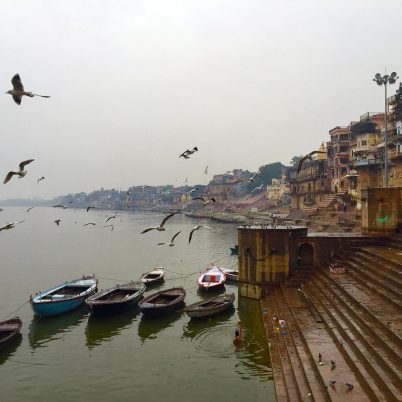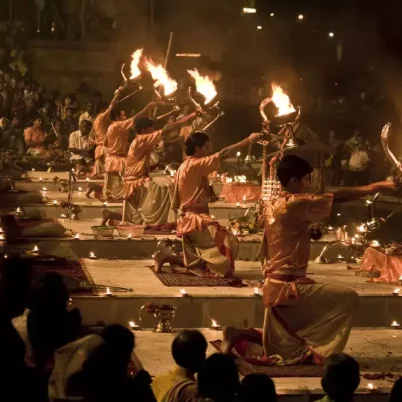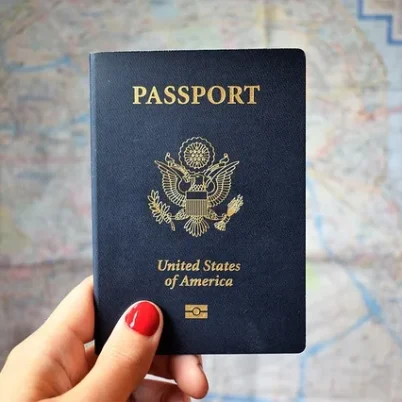
India has some of the best food in the world – vibrant, flavorful, and delicious. However, for a first-timer, ordering Indian food can be overwhelming. In our guide, “How to order food at Indian restaurants for foreigners?”, we take you through the process of ordering food at an Indian restaurant for the best experience. Read on to find out more!
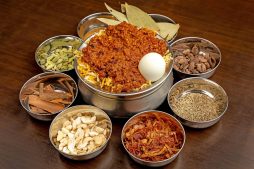
Understand the Indian cuisine
Indian food in most of the world is majorly associated with North Indian dishes such as Butter Chicken, Chicken Tikka Masala, Saag Paneer, and Naan. However, Indian cuisine is so much more than that. In fact, the flavors and ingredients of dishes are different in every region. Additionally, India is a paradise for vegetarians. There are so many vegetarian options here that you may not want to try any non-vegetarian dishes at all! Here is a guide to vegetarian food in India.
To make ordering in an Indian restaurant simpler, let’s break it down to the broader regions of India, but remember that this is still a generalization.
Northern India
North Indian food is characterized by thick, creamy curries, thicker breads like naan and parathas, and tandoor items. The cuisine is rich and dense, using a lot of dairy like ghee and cream. It includes dishes like chicken tikka masala, chicken dum biryani, kebabs, and tandoori chicken.
Southern India
Southern India has a tropical climate and this cuisine heavily uses coconut and tamarind. The food here is filling yet light to beat the heat. The curries are more watery than in the north, but still pack a punch. Dishes like idli, dosa, vada, sambar, rasam, fish curry, and rice are everyday staples here. You will also find food cooked and sometimes served in banana leaves.
Eastern India
East Indian cuisine is famous for its desserts like rosogolla, mishti doi, and sandesh. The flavors range from subtle to spicy from one region to another, but the cuisine staples are rice and fish. You will find some delicious dishes like fish curry, dalma, tenga, smoked meats, momos, and litti chokha in this region.
Western India
West Indian cuisine is extremely diverse, with spicy curries, simple vegetarian fares, scrumptious snacks, and unique sweets. This region uses a lot of spices in its food. The west coast will offer amazing dishes such as fish and prawn curries, the Goan pork vindaloo, spicy chicken and mutton curries, snacks like pani puri, vada pav, and dhokla, as well as sweet dishes like puran poli, bebinca, ghewar, and modak.
Central India
The cuisine in Central India is simple yet hearty. This cuisine has earthy flavors and uses a lot of wheat, pulses, and rice in its dishes. The food uses local produce and is a balanced mix of vegetarian and non-vegetarian dishes such as poha and jalebi, bhutte ka kees, faraa, aamat, imarti, and mawa bati.
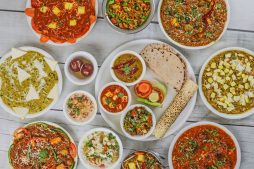
Choose the right restaurant
There are different types of restaurants in India, such as casual places like small eateries or local dhabas, mid-range restaurants which are clean and comfortable, perfect for families, and high-end restaurants, which are fine-dine and posh.
If you are visiting an Indian restaurant for the first or second time, choose a mid-range or upscale restaurant. This is because the menus here are easier to understand and most of the staff speaks English and can guide you in your order.

Understand the menu and flow of food
The flow of food in an Indian restaurant is usually the same as any other three-course meal – soups and appetizers, main course, and dessert. If an Indian restaurant serves both veg and non-veg items, the items will be distinctly marked.
Other categories in the menu include:
Soups: Indian restaurants usually include a few regional soups, such as tomato soup, Kashmiri yakhni soup, or dal shorba. Many Indian restaurants have Indo-chinese soups on the menu, and these are very different from anything you would have tried in authentic Chinese restaurants.
Starters (appetizers): these include kebabs, tikkas, tandoori, samosas, chaat, and more. You will find a wide variety of starters that you must try.
Main course: the main course in Indian restaurants includes rich gravies, curries, and dals. The vegetarian options have paneer, mushroom, or mixed vegetable curries, while the non-vegetarian alternatives are mostly chicken, mutton, or seafood curries.
Breads: Indian breads include naan, roti, paratha, chapati, or neer dosa. These breads are eaten with the main course to soak up the gravy, and this is a combination best eaten with your hand.
Rice: you can also eat curries with rice dishes. You will get plain rice, jeera rice, pulao, dal khichdi, and biryani in most Indian restaurants.
Sides: Sides will include raita, chutneys, pickles, and other dips which usually accompany the main dishes. You can also order papad which you can eat with your food or on its own.
Desserts: Indian desserts are diverse and beautiful in their flavors. Some of the most popular Indian desserts include gulab jamun, gajar halwa, kheer, and kulfi.
Drinks: while you get many aerated drinks in most restaurants, try the authentic Indian drinks such as masala chai, lassi, buttermilk, or fresh lime soda. It is recommended that you drink masala chai after a meal, but you can enjoy the other drinks while enjoying your food.
Respect your spice tolerance
It is true that not all Indian food is spicy. However, there are a few Indian dishes that can be extremely spicy for someone who is not used to the heat. So understand your spice tolerance and order accordingly, unless you really want to get adventurous.
If you do not have a good spice tolerance, order something mild. However, instead of asking to make a spicy dish very mild, it is a good idea to choose milder dishes. For some dishes in India, taking out the spice means taking out the essence of the dish.
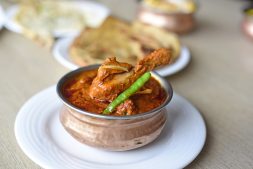
Ask about the quantity of the dish
Many westerners are used to ordering individual dishes for each person, but in India and many Asian countries, meals are a communal event and food is meant to be shared with everyone. The quantity of one dish in India is usually meant to serve 2 to 3 people, but always check first. Instead of ordering a full three-course meal for every individual, order different dishes and share them all together.
Get a thali
If you are confused and overwhelmed about what to eat, get a thali. You will get a veg or non-veg thali in many Indian restaurants. A thali contains all the components of a regular Indian meal – one or two appetizers, one or two gravies or curries, one dry vegetarian or non-vegetarian main course, bread, rice, dessert, and sides.
A thali lets you enjoy different types of dishes without having to make a choice. Plus, you get unlimited rice in many places. One thali is enough for one or sometimes even two people.

Some other tips to remember
- Indian cuisine can be quite overwhelming, so don’t hesitate to ask questions. Ask your server what they would recommend, which dishes suit your spice preferences, and which dishes to pair together, and they will be happy to answer.
- When you order your food, inform the server about your allergies, if any. Many Indian dishes use dairy products and may have nuts, so ensure that the staff knows about it.
- Stick to the cuisine the restaurant specializes in. India offers a range of different regional cuisines, so when you visit an Indian restaurant, order what they specialize in to get an authentic experience.
- Try new things. Indian food can seem intimidating, but if you feel like trying something different, ask the server about it and go ahead and try it.
- If you are dining with kids, there are many Indian dishes that are mild and suitable for children, such as rice and dal, vegetable pulao, malai kofta, stuffed parathas, and desserts.
- Try eating with your hands. Indians traditionally eat with their right hand, and you should definitely try it. However, if you cannot manage, cutlery is available.
- Always ask for bottled mineral water in any restaurant. Most places will give you the option of regular water or mineral water, so always choose mineral water.
- Tipping in India isn’t mandatory, but it is greatly recommended and appreciated. Tip 5 to 10% of the total bill in basic restaurants, and 10 to 15% in upscale dining establishments. Here is a guide for tipping in India.
Was this guide useful? What will you be ordering next at an Indian restaurant? Let us know! At India Someday, we create personalized itineraries to India for you based on your likes and preferences. Contact us and together we can plan the perfect trip to India for you!
Frequently Asked Questions
A good Indian order includes a balanced mix of appetizers, curries, rice, and bread. Some of the best dishes to try are butter chicken, kebabs, tandoori chicken, biryani, masala dosa, and vegetable pulao.
Rice is the most consumed food in India. It is made in various forms, such as jeera rice, pulao, khichdi, and biryani. Plain rice is paired with dal, vegetables, and curries. Other commonly consumed foods include curries, lentils, and Indian breads.
There is no one specific dish in India which is better than the rest, but biryani comes close. Biryani is a flavorful rice preparation that is prepped and cooked for hours. The result is a rich and aromatic blend of rice, spices, and chicken or mutton.
helping you travel your way
Everything you need to know about India is here We have tried writing about everything you may need help with for your trip to India, If you need help in planning a trip to India Get in touch with us to to plan your trip of a life time.


